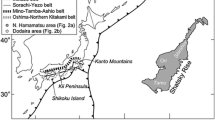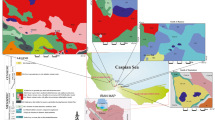Abstract
Sills, pillow lavas and hyaloclastites of the HFSE-rich picrite and related rocks (ankaramite and basanite) occur in the Middle Permian cherts in the Mino Jurassic accretionary complex, southwestern Japan. These rocks show systematic trace element patterns enriched in incompatible elements, which indicate that the associated ankaramite and basanite are formed by the crystal fractionation from the picrite. The presence of the hyaloclastite in the chert sequence covering a large tholeiitic greenstone body indicates that the picrite was produced in an intraoceanic setting in the Middle Permian time subsequent to the extrusion of the voluminous oceanic island tholeiite. The Mino picrites resemble the Siberian meimechite and Polynesian picrites in its HFSE-rich chemical composition. The HFSE enrichment in these picrites cannot be explained by low degree of partial melting of primitive peridotite mantle only, and needs a source material involving recycled oceanic crust (eclogite). The differences in MgO content and in TiO2/Al2O3 and Zr/Y ratios among the HFSE-rich picrites indicate that the melting pressure increases from the Polynesian picrite through Mino picrite to Siberian picrite. This may reflect the increasing thickness of the overlying lithosphere at the time and place of magmatism. The HFSE-rich picrites may be a product of a superplume event. The presence of HFSE-rich picrite in Mino and Siberia indicate that the superplume activities occur in both continental and oceanic settings in the Permian time.










Similar content being viewed by others
References
Ando A, Kamioka H, Terashima S, Itoh S (1989) 1988 values for GSJ rock reference samples, “igneous rock series”. Geochem J 23:143–148
Arndt N, Lehnert K, Vasil’ev Y (1995) Meimechites: highly magnesian alkaline magmas from the subcontinental lithosphere? Lithos 34:41–59
Arndt N, Chauvel C, Czamanske G, Fedorenko V (1998) Two mantle sources, two plumbing systems: tholeiitic and alkaline magmatism of the Maymecha River basin, Siberian flood volcanic province. Contrib Mineral Petrol 133:297–313
Asahara Y, Ohtani E (2001) Melting relations of the hydrous primitive mantle in the CMAS-H2O system at high pressures and temperatures, and implications for generation of komatiites. Phys Earth Planet Interiors 125:31–44
Asahara Y, Ohtani E, Suzuki A (1998) Melting relations of hydrous and dry mantle compositions and the genesis of komatiite. Geophys Res Lett 25:2201–2204
Becker H, Jochum KP, Carlson RW (2000) Trace element fractionation during dehydration of eclogites from high-pressure terranes and the implications for element fluxes in subduction zones. Chem Geol 163:65–99
Bernstein S, Leslie AG, Higgins AK, Brooks CK (2000) Tertiary alkaline volcanics in the Nunatak Region, Northeast Greenland: new observations and comparison with Siberian maymechites. Lithos 53:1–20
Bessho B (1968) Dynamics of mountains (with geological sheet map at 1:50,000) (in Japanese). Geol Report Fac Edu Kanazawa Univ 1:364
Brown PE, Evans IB, Becker SM (1996) The Prince of Wales Formation: post-flood basalt alkali volcanism in the Tertiary of East Greenland. Contrib Mineral Petrol 123:424–434
Campbell IH, Czamanske GK, Fedorenko VA, Hill RI, Stepanov V (1992) Synchronism of the Siberian Traps and the Permian-Triassic boundary. Science 258:1760–1763
Chauvel C, Hofmann AW, Vidal P (1992) HIMU-EM: the French Polynesian connection. Earth Planet Sci Lett 110:99–119
Ellam RM (1992) Lithospheric thickness as a control on basalt geochemistry. Geology 20:153–156
Gibson SA (2002) Major element heterogeneity in Archean to recent mantle plume starting-heads. Earth Planet Sci Lett 195:59–74
Halliday AN, Lee D-C, Tommasini S, Davies GR, Paslick CR, Fitton JG, James DE (1995) Incompatible trace elements in OIB and MORB and source enrichment in the sub-oceanic mantle. Earth Planet Sci Lett 133:379–395
Hauri EH (1996) Major element variability in the Hawaiian mantle plume. Nature 382:415–419
Herzberg C, O’Hara (1998) Phase equilibrium constraints on the origin of basalts, picrites, and komatiites. Earth Sci Rev 44:39–79
Hirose K, Kushiro I (1993) Partial melting of dry peridotites at high pressures: determination of compositions of melts segregated from peridotite using aggregates of diamond. Earth Planet Sci Lett 114:477–489
Hirschmann MM, Stolper EM (1996) A possible role for garnet pyroxenite in the origin the ‘garnet signature’ in MORB. Contrib Mineral Petrol 124:185–208
Hofmann AW (1988) Chemical differentiation of the Earth: the relationship between mantle, continental crust, and oceanic crust. Earth Planet Sci Lett 90:297–314
Hofmann AW (1997) Mantle geochemistry: the message from oceanic volcanism. Nature 385:219–229
Ishiwatari A, Ichiyama Y (2004) Alaskan-type plutons and ultramafic lavas in Far East Russia, Northeast China, and Japan. Int Geol Rev 46:316–331
Ishiwatari A, Tsujimori T (2003) Paleozoic ophiolites and blueschists in Japan and Russian Primorye in the tectonic framework of East Asia: A synthesis. Island Arc 12:190–206
Isozaki Y (1997) Jurassic accretion tectonics of Japan. Island Arc 6:25–51
Isozaki Y, Maruyama S, Furuoka F (1990) Accreted oceanic materials in Japan. Tectonophysics 181:179–205
Jones G, Valsami-Jones E, Sano H (1993) Nature and tectonic setting of accreted basalts from the Mino terrane, central Japan. J Geol Soc Lond 150:1167–1181
Kamioka H, Tanaka T (1989) The problems in the analyses of geological material by INAA: an examination of the analytical results of GSJ rock reference samples (in Japanese with English abstract). J Geol Soc Jpn 95:835–850
Kawai M (1964) Geology of the neo district. With Geological Sheet Map at 1:50,000. Geological Survey of Japan (in Japanese with English abstract)
Kimura G, Sakakibara M, Okamura M (1994) Plumes in central Panthalassa? Deductions from accreted oceanic fragments in Japan. Tectonics 13:905–916
Kogiso T, Tatsumi Y, Shimoda G, Barsczus HG (1997) High μ(HIMU) ocean island basalts in southern Polynesia: new evidence for whole mantle scale recycling subducted oceanic crust. J Geophys Res 102:8085–8103
Kogiso T, Hirose K, Takahashi E (1998) Melting experiments on homogeneous mixtures of peridotite and basalt: application to the genesis of ocean island basalts. Earth Planet Sci Lett 162:45–61
Kojima S (1989) Mesozoic terrane accretion in the northeast China, Sikhote-Alin, and Japan regions. Palaeogeograph Palaeoclimatol Palaeontol 69:213–232
Larson (1991) Latest pulse of Earth: evidence for a mid-Cretaceous superplume. Geology 19:547–550
Le Bas MJ (2000) IUGS classification of the high-Mg and picritic volcanic rocks. J Petrol 41:1467–1470
McKenzie D, O’Nions RK (1983) Mantle reservoirs and ocean island basalts. Nature 301:229–231
McKenzie D, O’Nions RK (1995) The source regions of ocean island basalts. J Petrol 36:133–159
Norman MD, Garcia MO (1999) Primitive magmas and source characteristics of the Hawaiian plume: petrology and geochemistry of shield picrites. Earth Planet Sci Lett 168:27–44
Ozawa H, Motoyama S, Inoue S, Kato Y, Murata M (1999) Petrology of basic volcanics of the Mikabu greenstone complex in the eastern Shikoku (in Japanese with English abstract). Mem Geol Soc Jpn 52:217–228
Peate DW, Baker JA, Blichert-Toft J, Hilton DR, Storey M, Kent AJR, Brooks CK, Hansen H, Pedersen AK, Duncan RA (2003) The Prinsen af Wales Bjerge Formation Lavas, East Greenland: the transition from tholeiitic to alkalic magmatism during palaeogene continental break-up. J Petrol 44:279–304
Perfit MR, Fornari DJ, Ridley WI, Kirk PD, Casey J, Kastens KA, Reynolds JR, Edwards M, Desonie D, Shuster R, Paradis S (1996) Recent volcanism in the Siqueiros transform fault: picritic basalts and implications for MORB magma genesis. Earth Planet Sci Lett 141:91–108
Roeder PL, Emislie RF (1970) Olivine-liquid equilibrium. Contrib Mineral Petrol 29:275–289
Sakakibara M, Hori R, Kimura G, Ikeda M, Koumoto T, Kato H (1999) The age of magmatism and petrochemical characteristics of the Sorachi plateau reconstructed in Cretaceous accretionary complex (in Japanese with English abstract). Mem Geol Soc Jpn 52:1–15
Sano H (1988a) Permian oceanic rocks of Mino terrane, central Japan. Part I chert facies. J Geol Soc Jpn 94:697–709
Sano H (1988b) Permian oceanic rocks of Mino terrane, central Japan. Part II limestone facies. J Geol Soc Jpn 94:963–976
Shaw DM (1970) Trace element fractionation during anatexis. Geochim Cosmochim Acta 34:237–43
Sobolev AV, Kamenetskiy VS, Kononkova NN (1991) New data on Siberian Meymechite petrology. Geochem Int 29:10–20
Sun SS, McDonough WF (1989) Chemical and isotopic systematics of oceanic basalts: implications for mantle composition and processes. In: Saunders AD, Norry MJ (eds) Magmatism in the ocean basins. Geological Society, London, pp 313–345
Suzuki S (1997) Petrology of anthracite in the Permian Funabuseyama limestone, Mino belt, central Japan (in Japanese with English abstract). J Geol Soc Jpn 103:869–879
Takahashi E, Nakajima K, Wright TL (1998) Origin of the Columbia River basalts: melting model of a heterogeneous plume head. Earth Planet Sci Lett 162:63–80
Tatsumi Y, Shinjoe H, Ishizuka H, Sager WW (1998) Geochemical evidence for a mid-Cretaceous superplume. Geology 26:151–154
Tatsumi Y, Kani T, Ishizuka H, Maruyama S, Nishimura Y (2000) Activation of Pacific mantle plumes during the Carboniferous: evidence from accretionary complexes in southwest Japan. Geology 28:580–582
Wakita K (1988) Origin of chaotically mixed rock bodies in the Early Jurassic to Early Cretaceous sedimentary complex of the Mino terrane, central Japan. Bull Geol Surv Jpn 39:675–757
Wakita K (1991) Geology of the Tanigumi district. With Geological Sheet Map at 1:50,000. Geological Survey of Japan (in Japanese with English abstract)
Walter MJ (1998) Melting of garnet peridotite and the origin of komatiite and depleted lithosphere. J Petrol 39:29–60
Weaver BL (1991) The origin of oceanic island basalt end-member compositions: trace element and isotopic constraints. Earth Planet Sci Lett 104:115–118
Woodhead JD (1995) Extreme HIMU in an oceanic setting: the geochemistry of Mangaia Island (Polynesia), and temporal evolution of the Cook-Austral hotspot. J Volcanol Geotherm Res 72:1–19
Yasuda A, Fujii T, Kurita K (1997) A composite diapir model for extensive basaltic volcanism: magmas from subducted oceanic crust entrained within mantle plumes. Proc Jpn Acad B 73:201–204
Yaxley GM (2000) Experimental study of the phase and melting relations of homogeneous basalt + peridotite mixtures and implications for the petrogenesis of flood basalts. Contrib Mineral Petrol 139:326–338
Yaxley GM, Green DH (1998) Reactions between eclogite and peridotite: mantle refertilisation by subduction of oceanic crust. Schweiz Mineral Petrogr Mitt 78:243–255
Acknowledgments
We thank Prof. S. Arai, Dr. A. Toramaru and Dr. T. Morishita of Kanazawa University for several discussions. We acknowledge the comments of the anonymous reviewers, which helped us to improve the manuscript. Mr. K. Koizumi is thanked for his assistance in the fieldwork. Mr. Y. Shimizu also is thanked for his assistance in EPMA analysis. The second author acknowledges a Grant-in-Aid for Scientific Research (C)-(2)-14540447 by the Ministry of Education, Culture, Sports, Science and Technology, Japan.
Author information
Authors and Affiliations
Corresponding author
Additional information
Communicated by A. Hofmann
Rights and permissions
About this article
Cite this article
Ichiyama, Y., Ishiwatari, A. HFSE-rich picritic rocks from the Mino accretionary complex, southwestern Japan. Contrib Mineral Petrol 149, 373–387 (2005). https://doi.org/10.1007/s00410-005-0659-6
Received:
Accepted:
Published:
Issue Date:
DOI: https://doi.org/10.1007/s00410-005-0659-6




